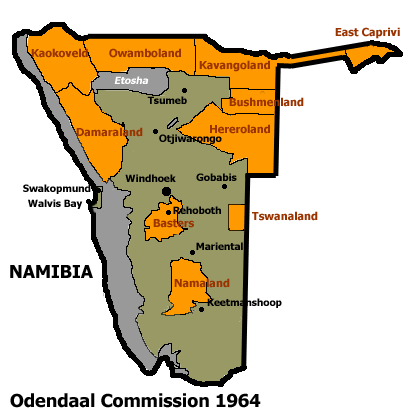Damaraland In Namibia on:
[Wikipedia]
[Google]
[Amazon]
 Damaraland was a name given to the north-central part of
Damaraland was a name given to the north-central part of

Vingerclip Rock Formation, Damaraland, Namibia
{{Coord, -22.25, 15.19, display=title, source:wikidata, qid=Q1158213 Bantustans in South West Africa Damara people States and territories established in 1980 States and territories disestablished in 1989 1980 establishments in South West Africa 1989 disestablishments in South West Africa
 Damaraland was a name given to the north-central part of
Damaraland was a name given to the north-central part of South West Africa
South West Africa was a territory under Union of South Africa, South African administration from 1915 to 1990. Renamed ''Namibia'' by the United Nations in 1968, Independence of Namibia, it became independent under this name on 21 March 1990. ...
, which later became Namibia
Namibia, officially the Republic of Namibia, is a country on the west coast of Southern Africa. Its borders include the Atlantic Ocean to the west, Angola and Zambia to the north, Botswana to the east and South Africa to the south; in the no ...
, inhabited by the Damaras. It was bordered roughly by Ovamboland
Ovamboland, also referred to as Owamboland, was a Bantustan and later a non-geographic ethnic-based second-tier authority, the Representative Authority of the Ovambos, in South West Africa (present-day Namibia).
The apartheid government stat ...
in the north, the Namib Desert
The Namib ( ; ) is a coastal desert in Southern Africa. According to the broadest definition, the Namib stretches for more than along the Atlantic coasts of Angola, Namibia, and northwest South Africa, extending southward from the Carunjamba Ri ...
in the west, the Kalahari Desert
The Kalahari Desert is a large semiarid climate, semiarid sandy savanna in Southern Africa covering including much of Botswana as well as parts of Namibia and South Africa.
It is not to be confused with the Angolan, Namibian, and South African ...
in the east, and the Windhoek
Windhoek (; ; ) is the capital and largest city of Namibia. It is located in central Namibia in the Khomas Highland plateau area, at around above sea level, almost exactly at the country's geographical centre. The population of Windhoek, which ...
region in the south.
Administrative history

Bantustan
In the 1970s the name Damaraland was chosen for aBantustan
A Bantustan (also known as a Bantu peoples, Bantu homeland, a Black people, black homeland, a Khoisan, black state or simply known as a homeland; ) was a territory that the National Party (South Africa), National Party administration of the ...
, intended by the apartheid
Apartheid ( , especially South African English: , ; , ) was a system of institutionalised racial segregation that existed in South Africa and South West Africa (now Namibia) from 1948 to the early 1990s. It was characterised by an ...
-era government to be a self-governing homeland for the Damara people. The Bantustan Damaraland was situated on the western edge of the territory that had been known as Damaraland in the 19th century.
Representative authority (1980–1989)
Following the Turnhalle Constitutional Conference the system ofBantustan
A Bantustan (also known as a Bantu peoples, Bantu homeland, a Black people, black homeland, a Khoisan, black state or simply known as a homeland; ) was a territory that the National Party (South Africa), National Party administration of the ...
s was replaced in 1980 by Representative Authorities which functioned on the basis of ethnicity only and were no longer based on geographically defined areas.
The Representative Authority of the Damaras had executive and legislative competencies, being made up of elected Legislative Assemblies which would appoint Executive Committees led by chairmen.
As second-tier authorities, forming an intermediate tier between central and local government, the representative authorities had responsibility for land tenure, agriculture, education up to primary level, teachers' training, health services, and social welfare and pensions and their Legislative Assemblies had the ability to pass legislation known as Ordinances.
Transition to independence (1989–1990)
Damaraland, like other homelands in South West Africa, was abolished in May 1989 at the start of the transition toindependence
Independence is a condition of a nation, country, or state, in which residents and population, or some portion thereof, exercise self-government, and usually sovereignty, over its territory. The opposite of independence is the status of ...
.
The name Damaraland predates South African control of Namibia, and was described as "the central portion of German South West Africa
German South West Africa () was a colony of the German Empire from 1884 until 1915, though Germany did not officially recognise its loss of this territory until the 1919 Treaty of Versailles.
German rule over this territory was punctuated by ...
" in the Encyclopædia Britannica Eleventh Edition
The ''Encyclopædia Britannica'' Eleventh Edition (1910–1911) is a 29-volume reference work, an edition of the ''Encyclopædia Britannica''. It was developed during the encyclopaedia's transition from a British to an American publication. So ...
.
Leadership
Justus ǁGaroëb was the chairman of the Executive Committee from 1980 to 1989.See also
*Apartheid
Apartheid ( , especially South African English: , ; , ) was a system of institutionalised racial segregation that existed in South Africa and South West Africa (now Namibia) from 1948 to the early 1990s. It was characterised by an ...
* Bantustans in South West Africa
* Diocese of Namibia
The Diocese of Namibia is part of the Anglican Church of Southern Africa, which is itself part of the Anglican Communion. The diocese, which covers the whole country of Namibia, was originally known as the Diocese of Damaraland. Most of the Angl ...
(formerly Diocese of Damaraland)
References
External links
Vingerclip Rock Formation, Damaraland, Namibia
{{Coord, -22.25, 15.19, display=title, source:wikidata, qid=Q1158213 Bantustans in South West Africa Damara people States and territories established in 1980 States and territories disestablished in 1989 1980 establishments in South West Africa 1989 disestablishments in South West Africa